The teacup Bichon Frise is like having a living cotton ball with a heart of gold. This downsized version of the classic Bichon Frise is bred to be smaller, usually weighing just 5–9 pounds when fully grown. Their fluffy, hypoallergenic coats, bright eyes, and joyful personalities make them one of the most charming toy-sized companions you’ll ever meet.
When people search for the teacup Bichon Frise price, they’re usually surprised at how much these pups can cost. Because of their rarity and popularity, prices often range from $2,500 to $5,000 USD, depending on breeder reputation, size, and color variation. While the cost may be high, many owners say their endless affection and playful spirit are priceless.
Origin & History of the Teacup Bichon Frise
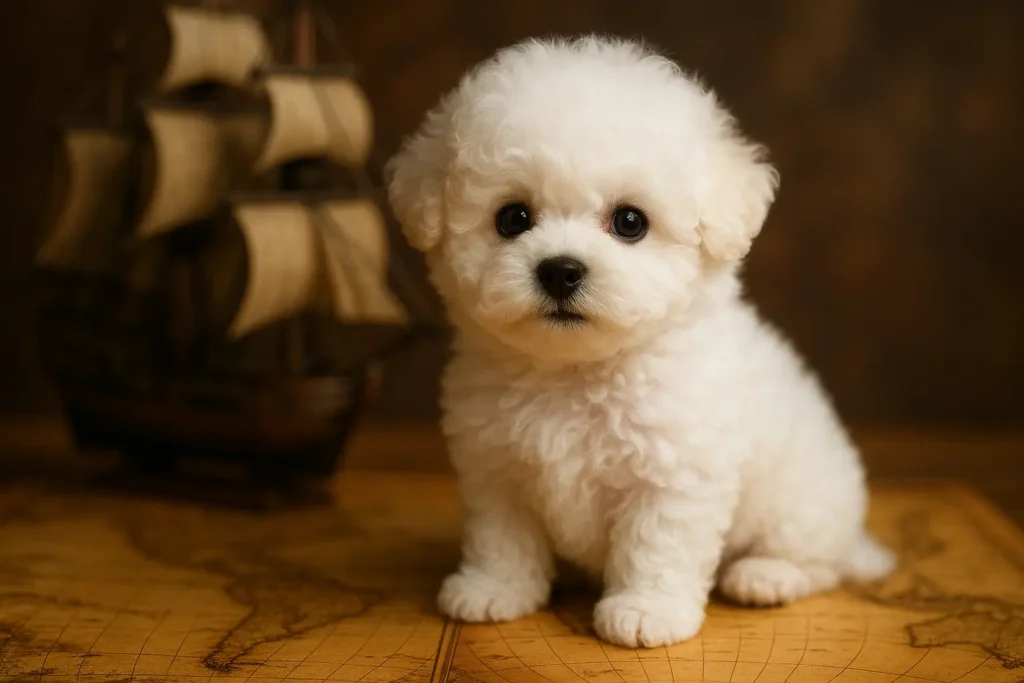
The story of the teacup Bichon Frise begins with its larger cousin, the standard Bichon Frise, one of Europe’s most beloved companion breeds.
Ancient Roots
The Bichon Frise descended from small white dogs found in the Mediterranean region as far back as the 13th century. Sailors often carried them on ships as companions and trading dogs.
Rise in Popularity
By the Renaissance era, the Bichon Frise became a symbol of luxury and charm in French and Spanish royal courts. Their fluffy white coats, cheerful personalities, and affectionate nature made them favorites among nobles and artists. They were often seen in paintings alongside royalty, a true sign of their high status.
Modern Recognition
The standard Bichon Frise was officially recognized by the American Kennel Club (AKC) in 1973. Since then, it has grown into one of the most popular family and companion dogs worldwide, thanks to its hypoallergenic coat and playful personality.
The Teacup Variation
The teacup Bichon Frise is not an AKC-recognized size but was developed through selective breeding of the smallest Bichons. The goal was to create an even tinier companion, perfect for apartment living and city lifestyles. Full-grown, they weigh only 5–9 pounds and stand 7–9 inches tall, yet still carry the same fluffy charm and friendly temperament as their larger cousins.
Size & Appearance of a Full-Grown Teacup Bichon Frise
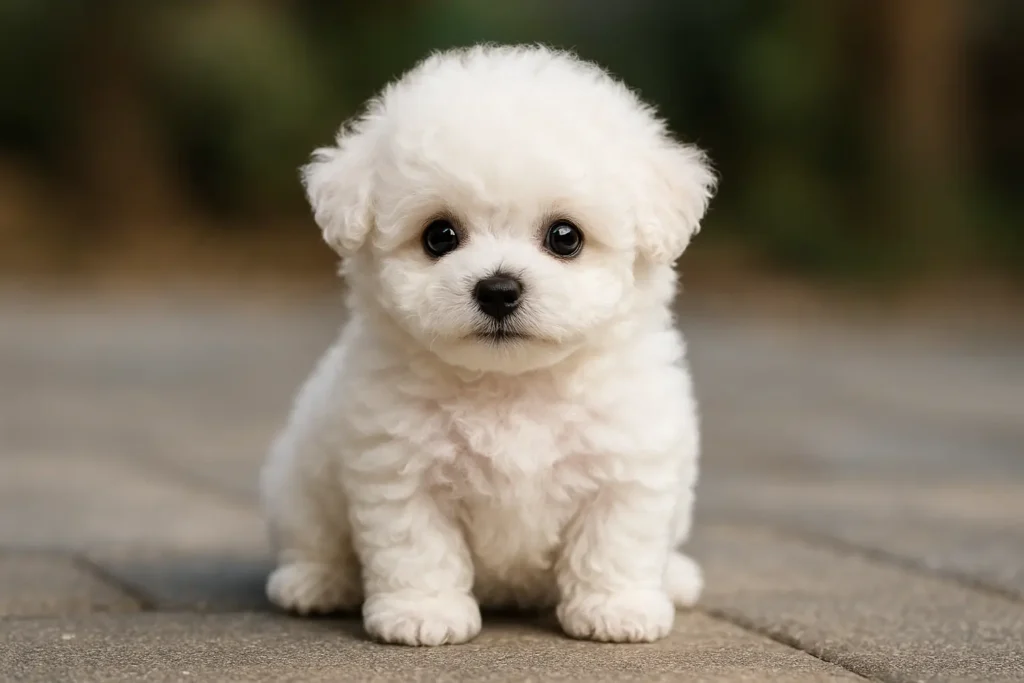
The full-grown teacup Bichon Frise is a tiny version of the classic Bichon, but don’t let the size fool you, these little dogs still carry the breed’s signature fluffy, cloud-like coat and cheerful personality.
General Size
- Weight: 5–9 pounds (adult)
- Height: 7–9 inches at the shoulder
Much smaller than the standard Bichon Frise, which usually weighs 10–18 pounds.
Body Build
- Compact and sturdy despite their small frame
- Rounded skull, bright dark eyes, and a black button nose
- Straight back and well-balanced legs that give them a lively, bouncy gait
Coat Variants
The coat is always a double coat:
- Undercoat: Soft and dense, providing volume
- Outer coat: Curly or wavy, giving the cotton-ball appearance
Colors include:
- Classic pure white (most common)
- Cream or apricot shading (often fades with age)
- Light brown or beige tints in rare cases
Growth Timeline
- 8 weeks: 1–2 pounds
- 6 months: 4–6 pounds
- 9–12 months: Reach full height (7–9 inches) and adult weight (5–9 pounds)
Appearance as Adults
A full-grown teacup Bichon Frise looks like a miniature teddy bear. Their coat grows continuously and needs regular grooming to maintain the fluffy, rounded look. Many owners choose a puppy cut or teddy cut for easier maintenance while still keeping the breed’s signature charm.
Coat Variants of the Teacup Bichon Frise
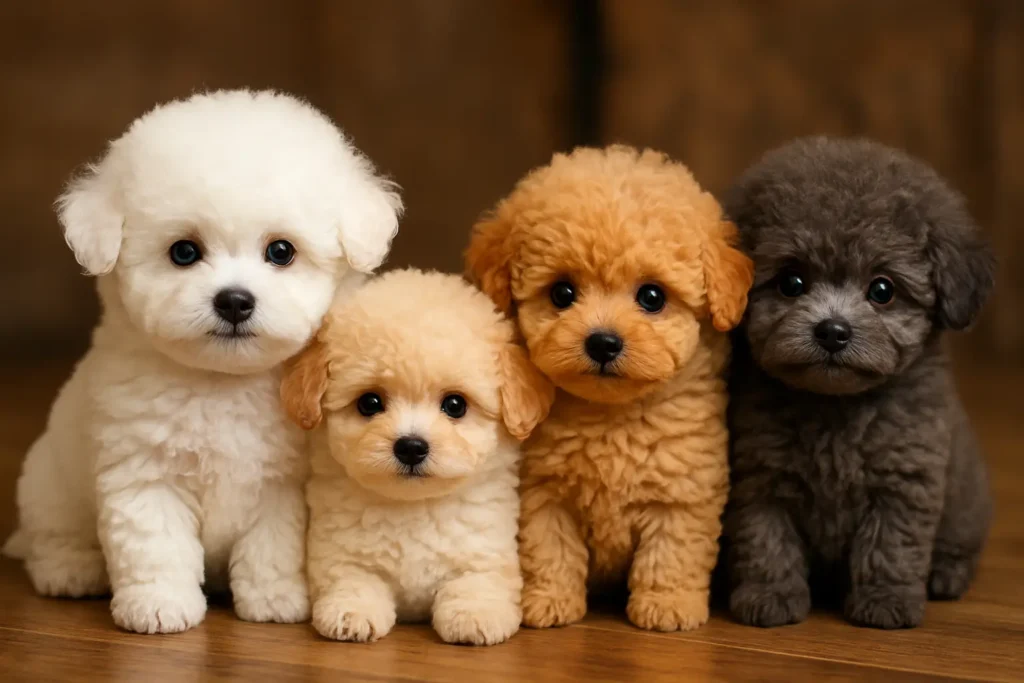
The teacup Bichon Frise is best known for its powder-puff, cotton-like coat. While the classic image is a pure white fluffball, these little dogs can come in a few subtle coat variants, especially when they’re young.
Main Coat Variants
- Pure White (Most Common)
- The traditional and most recognized color.
- Soft, curly double coat gives the breed its cloud-like appearance.
- White with Cream or Apricot Shading
- Some puppies are born with light cream or apricot hues, often around the ears, back, or muzzle.
- These usually fade to white as they mature.
- White with Brown Tint (Rare)
- A less common but unique look.
- May appear as beige or light chocolate highlights.
- In many cases, the tint softens into cream or fades to white over time.
- White with Gray Markings
- Rare in teacup Bichons.
- Gray shading often shows in very young puppies but typically disappears as the adult coat develops.
Coat Texture
Regardless of color, all teacup Bichons share the same double coat:
- Undercoat: Dense and soft
- Outer coat: Curly or wavy, creating the breed’s signature fluffy look
Grooming Needs
Because the coat continuously grows and traps loose hair, regular grooming is essential. Without brushing, mats and tangles can form quickly. Professional grooming every 4–6 weeks plus frequent at-home brushing keeps the coat healthy and stylish.
Growth & Weight Chart: Teacup Bichon Frise
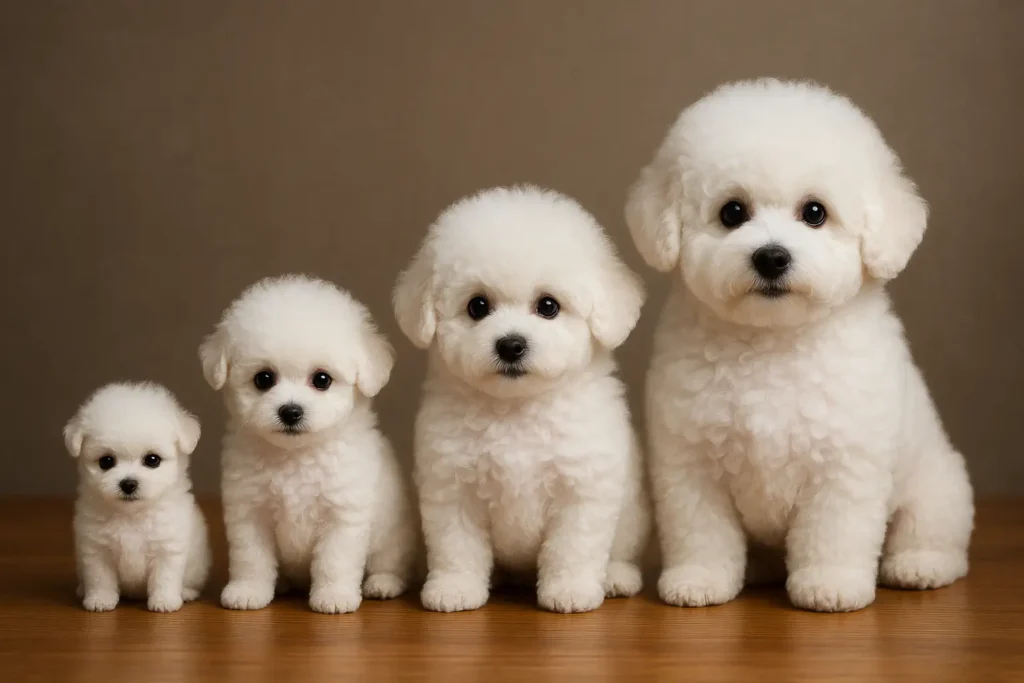
The teacup Bichon Frise grows quickly during the first few months of life, then slows down until they reach their final size by about a year old. Because they’re much smaller than the standard Bichon, their growth curve is petite but steady.
Male Teacup Bichon Frise Growth
| Age | Weight | Height (shoulder) |
| 8 weeks | 1.5 – 2 lbs | 4 – 5 in |
| 3 months | 2.5 – 4 lbs | 5 – 6 in |
| 6 months | 4 – 6 lbs | 6 – 7 in |
| 9 months | 5 – 7 lbs | 7 – 8 in |
| 12 months (adult) | 6 – 9 lbs | 8 – 9 in |
Female Teacup Bichon Frise Growth
| Age | Weight | Height (shoulder) |
| 8 weeks | 1 – 1.8 lbs | 3.5 – 4.5 in |
| 3 months | 2 – 3.5 lbs | 4.5 – 5.5 in |
| 6 months | 3.5 – 5.5 lbs | 5.5 – 6.5 in |
| 9 months | 4.5 – 6.5 lbs | 6.5 – 7.5 in |
| 12 months (adult) | 5 – 8 lbs | 7 – 8.5 in |
When Will a Teacup Bichon Stop Growing?
Most teacup Bichons reach their adult height by 8–9 months. They continue to fill out in weight until about 12 months, after which they’re considered fully grown.
Full-Grown Size
- Males: 6–9 lbs, 8–9 inches tall
- Females: 5–8 lbs, 7–8.5 inches tall
Teacup Bichon Frise: Breed Overview
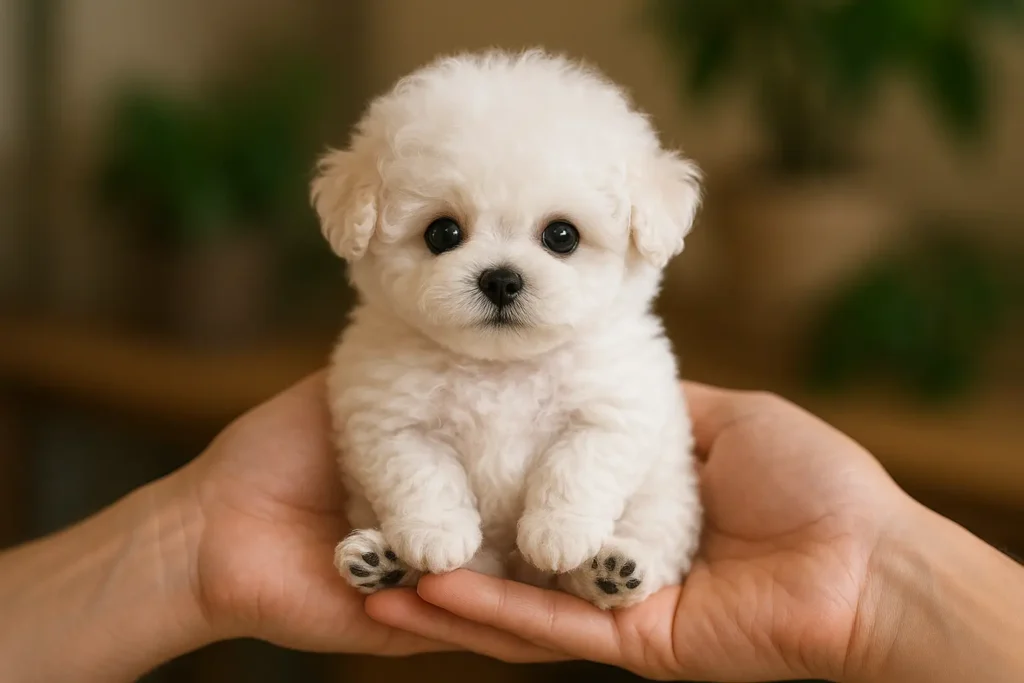
The teacup Bichon Frise is a downsized version of the standard Bichon , still fluffy, playful, and affectionate, but in a much smaller package. Here’s a quick overview of what makes this tiny pup special.
Size
- Extra small, toy-sized companion
- Sturdy yet compact build
Group
- Officially, the Bichon Frise belongs to the Non-Sporting Group (AKC)
- Teacup size is not AKC recognized, but falls under toy companion dogs
Height
- Males: 8–9 inches
- Females: 7–8.5 inches
Weight
- Males: 6–9 lbs
- Females: 5–8 lbs
Coat
- Dense double coat: soft undercoat with curly or wavy outer coat
- Requires daily brushing and regular professional grooming
Coat Color
- Classic pure white (most common)
- Light cream, apricot, beige, or brown-tinted coats (rare and usually fade to white with age)
Lifespan
- 12–15 years, sometimes longer with proper care
Temperament
- Cheerful and affectionate
- Playful, friendly, and family-oriented
- Sensitive and thrives on companionship
Hypoallergenic
Yes, Their low-shedding coat makes them hypoallergenic, a great option for allergy sufferers.
Origin
- Descended from Mediterranean lapdogs
- Became favorites in French and Spanish royal courts during the Renaissance
- Teacup variety is a modern trend developed through selective breeding
Price
- $2,500–$5,000 USD, depending on breeder, pedigree, and rarity
Average Monthly Expenses
- Food: $20–$40
- Veterinary: $30–$60 (averaged yearly)
- Grooming: $40–$80
- Gear & Training: $20–$40
Total: $120–$240/month
Teacup Bichon Frise: Breed Characteristics
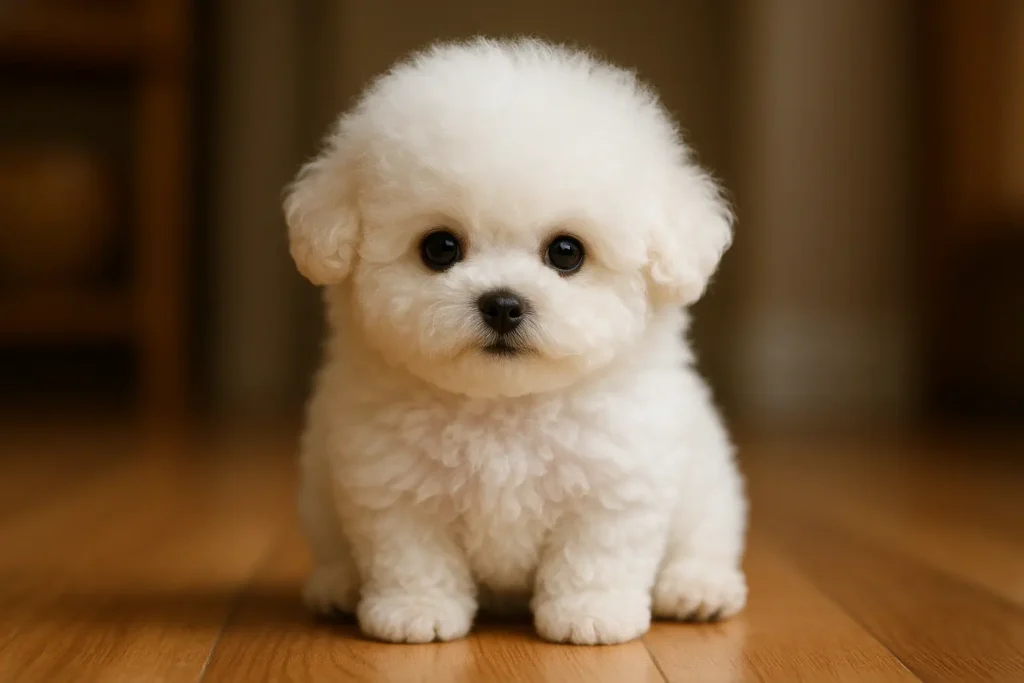
When you look at a teacup Bichon Frise, you see a walking puffball , but underneath that cotton-like coat is a lively, affectionate, and sensitive little dog. Here’s a deep dive into what makes them tick:
Affection Level
These pups are lap-dog champions. They bond closely with their families and thrive on constant companionship. A teacup Bichon won’t just follow you from room to room , they’ll climb right onto your lap the second you sit down. They’re happiest when they’re the center of attention, so expect plenty of cuddles and affection.
Friendliness
If you want a dog that greets your guests like long-lost friends, the teacup Bichon is it. They’re social butterflies and adapt quickly to new people. Unlike some toy breeds that are reserved, these dogs love showing off their cheerful side.
Kid-Friendly
Because of their tiny size, they do better with older children who understand gentle handling. A teacup Bichon can easily get injured by rough play, so while they’re incredibly sweet with kids, supervision is a must around toddlers.
Pet-Friendly
They generally get along well with other dogs and even cats, especially if raised together. Their playful, non-aggressive nature makes them great companions in multi-pet households. Early socialization helps prevent shyness or clinginess.
Exercise Needs
Teacup Bichons don’t need intense workouts. A couple of short walks combined with indoor play sessions (fetch, tug toys, or puzzle feeders) is plenty. Around 20–30 minutes a day keeps them fit and happy.
Playfulness
Nicknamed “forever puppies,” these little dogs never seem to lose their sense of fun. Whether it’s chasing a squeaky toy or playing hide-and-seek, their playfulness shines through. They’ll happily turn any room into their playground.
Energy Level
Moderate overall. They’ll burst into little zoomies, then plop down for a nap on your lap. Their energy comes in waves, which makes them manageable even for apartment dwellers.
Health
Here’s where being “teacup” can be tricky. Downsized Bichons are prone to certain conditions like dental crowding, fragile bones, hypoglycemia, patellar luxation, and allergies. Responsible breeding and regular veterinary care are essential. Despite their risks, many teacup Bichons live 12–15 years with proper care.
Sociability
They’re true people dogs. Leaving them alone for long periods can lead to separation anxiety, excessive barking, or destructive chewing. They do best in households where someone is home most of the day or with another gentle pet for company.
Trainability
These pups are smart, but their stubborn streak and small bladder can make potty training a challenge. Patience, consistency, and positive reinforcement are key. They respond well to treats and praise , and a little humor helps too.
Intelligence
The teacup Bichon is bright and quick to learn tricks, commands, and routines. They love mentally stimulating activities like interactive toys, obedience games, and agility exercises (yes, even toy dogs enjoy it!).
Tendency to Bark
They’re alert and will bark when they hear strange noises or see someone new, but they’re not chronic yappers. With proper training, you can manage their barking so it doesn’t get excessive.
Amount of Shedding
Low-shedding but high-maintenance. Their coats trap loose hairs, making them great for allergy sufferers, but you’ll need to brush daily to avoid tangles and mats. Professional grooming every 4–6 weeks keeps their coat fluffy and healthy.
Temperament & Personality of the Teacup Bichon Frise
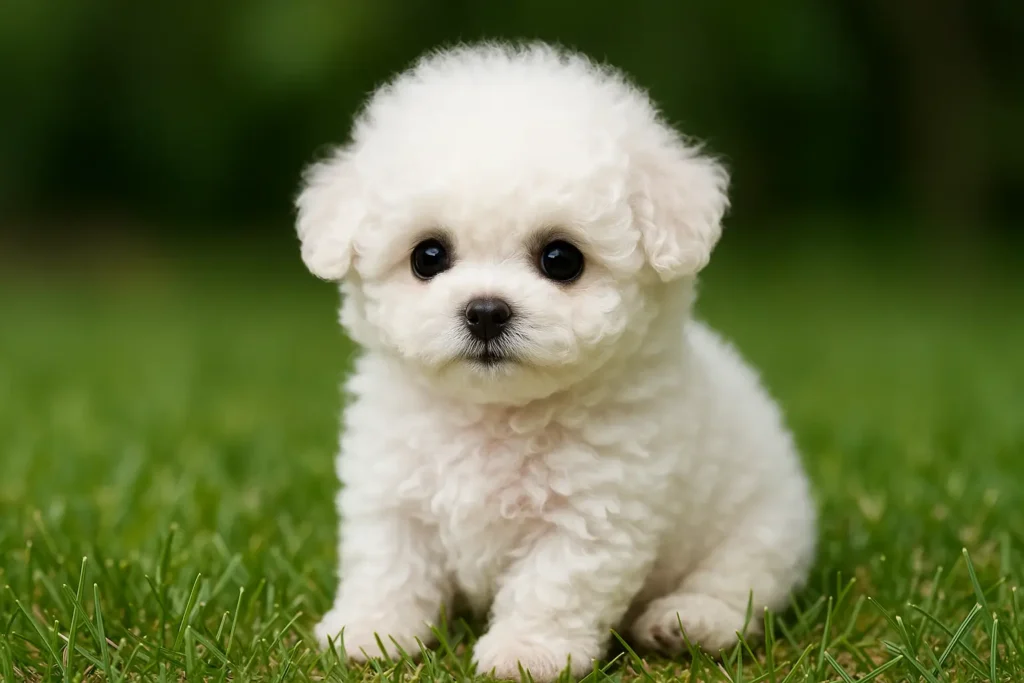
Living with a teacup Bichon Frise feels a bit like having a tiny ball of sunshine in your home. These pups have a personality that’s bigger than their body, and they know exactly how to win hearts.
Cheerful & Playful
One of the first things you’ll notice is how happy-go-lucky they are. Teacup Bichons are often described as “forever puppies” because they keep that silly, playful spirit well into adulthood. Whether it’s chasing a squeaky toy or doing zoomies around the living room, they have a way of turning even a dull day into something joyful.
Affectionate Companions
These little fluffballs are true lap dogs. They thrive on closeness and want to be wherever you are , from following you into the kitchen to curling up beside you during movie night. They form deep bonds with their humans and aren’t shy about showing love through cuddles and kisses.
Social Butterflies
Unlike some toy breeds that can be aloof, the teacup Bichon loves meeting new people. They’re usually friendly with strangers, other dogs, and even cats if introduced properly. This makes them great companions for families and social households.
Sensitive Souls
They don’t handle harsh scolding well. A raised voice or rough handling can easily upset them, so gentle training methods work best. They respond beautifully to positive reinforcement with treats, praise, and consistency.
Alert but Not Aggressive
Teacup Bichons make surprisingly good little watchdogs. They’ll alert you with a bark if they hear unusual noises, but they’re not known for being overly yappy or aggressive. Their goal is to keep you aware, not scare anyone away.
Attention Seekers
If ignored for too long, they may bark, whine, or even develop separation anxiety. They’re happiest in homes where someone is around most of the day or where they have another pet companion to keep them company.
Dog Behavior: Teacup Bichon Frise
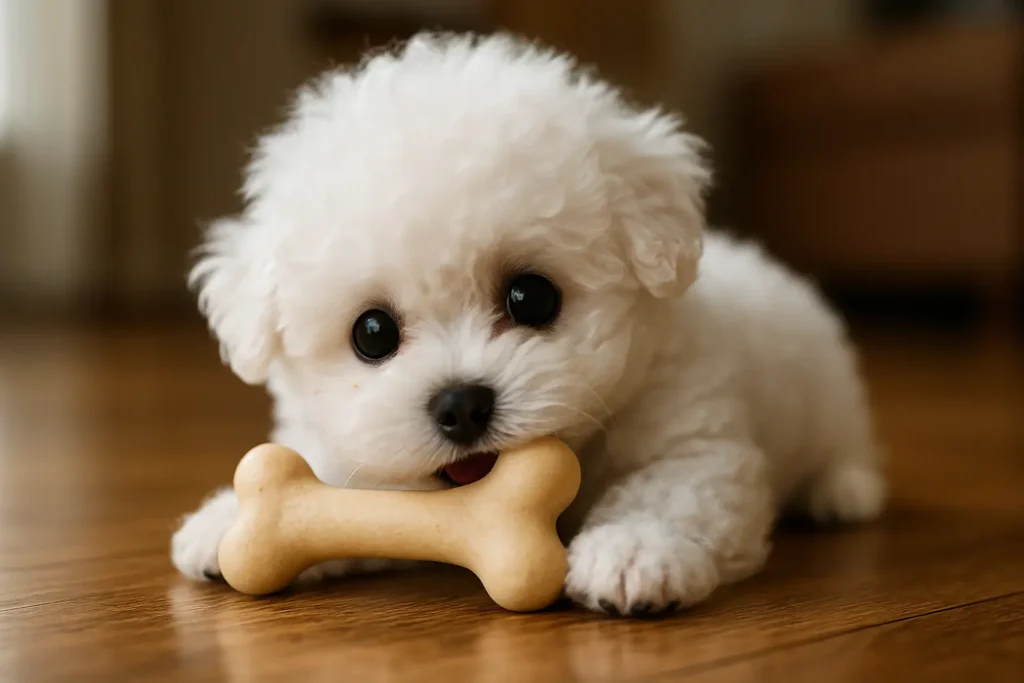
The teacup Bichon Frise might be small, but their behavior is full of character. They’re playful clowns at heart, sensitive companions by nature, and a little mischievous if you don’t keep them engaged. Here’s what you can expect from their day-to-day behavior:
Playful and Entertaining
Teacup Bichons love to play. They’ll chase toys, invent silly games, and sometimes even put on little “shows” with their zoomies. Their behavior is often compared to that of a cheerful child who just wants to keep everyone laughing.
Affection-Driven
These pups crave attention and closeness. A teacup Bichon will happily curl up in your lap, follow you from room to room, or nudge you when they feel like you’ve ignored them too long. They can become clingy if not given enough affection.
Alert and Watchful
Though small, they are attentive watchdogs. They’ll bark when they hear a knock at the door or notice movement outside. However, they aren’t aggressive , their barking is more about alerting than protecting.
Sensitive and Gentle
They respond best to positive reinforcement. Harsh training or being left alone for long stretches can lead to anxiety, whining, or destructive chewing. They need patience and gentle consistency to thrive.
With Kids and Pets
- With older kids, they’re playful and sweet.
- With toddlers, they need supervision since their small size makes them fragile.
- With other pets, they’re usually social and adapt well, especially if introduced early.
Mischievous Streak
Like many smart toy breeds, teacup Bichons can develop naughty habits if bored. They might chew on furniture, shred paper, or dig into laundry baskets just to entertain themselves. Keeping them mentally and physically stimulated helps curb this.
Cost of Buying Teacup Bichon Frise Puppies
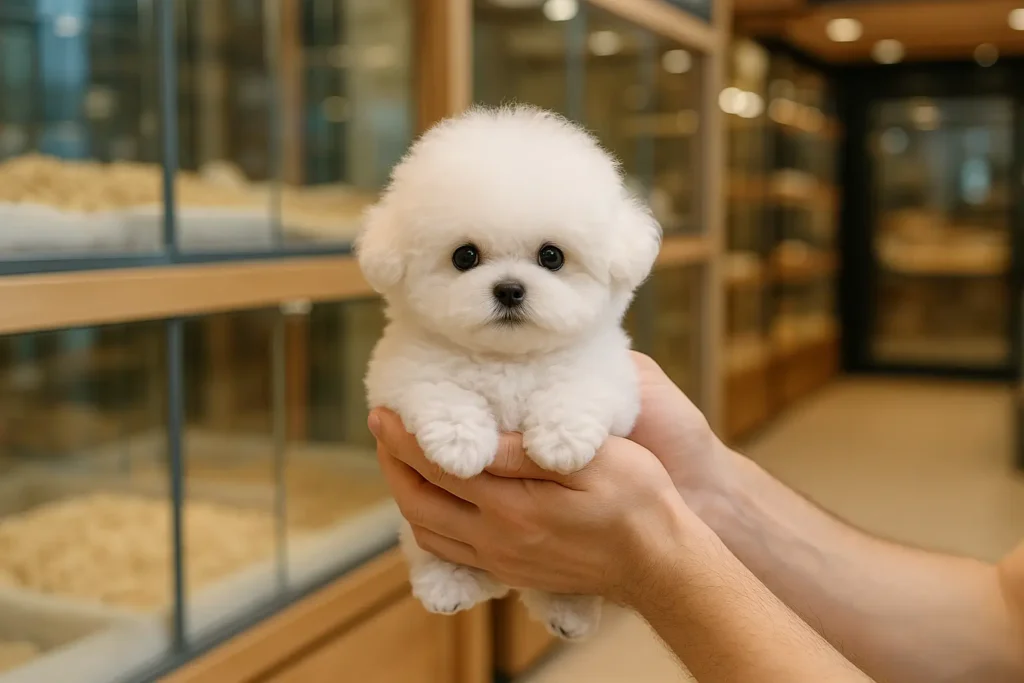
| Source | Typical Listed Price |
| Lowell Teacup Puppies | ~$3,000 to ~$6,700 USD depending on sex, rarity, color etc. |
| Velydog (teacup or mini versions) | ~$3,000 to ~$3,400 USD for teacup/mini Bichon Frise puppies. |
| Foufou Puppies | Some listed at ~$5,500 to ~$6,800 USD. |
| PawTale Puppies (tiny breeder) | They had a listing for teacup Bichon puppies “under 7 lbs” priced $1,195 USD though details like health guarantees aren’t always clear. |
| General Bichon Frise (non-teacup) | Reputable breeders normally charge between $1,500 to $3,500 USD for standard/mini versions. Teacup versions tend to cost more. |
Adoption vs Buyin
- Adoption (rescues/shelters) is generally cheaper. For standard Bichon Frise, adoption fees often run $50-$500 USD depending on age, health, location.
- Teacup-size or rare color puppies are much less common in rescues, so adopting a true teacup version might be harder to find and sometimes pricey if it’s a breed-specific rescue.
Things to Check & Be Careful About (“Red Flags”)
Because “teacup” isn’t an official classification, that means many breeders use the term loosely. Here are some things to verify:
- Health checks / guarantees: Parents’ genetic screening, disease clearances (eyes, heart, joints)
- Breeder reputation: Good reviews, transparency, willingness to show puppy in its environment
- Size claims: Make sure “teacup” is not just marketing; tiny pups can come with increased health risks (fragile bones, low blood sugar, etc.)
- Price extremely low: If it sounds “too good to be true,” it often is. Cheap “teacup” puppies may come from poor breeding practices.
What to Expect for “Price”
If you see listings or search for terms like “teacup bichon frise price,” “teacup bichon puppies for sale,” here’s roughly what those should mean in terms of cost tiers:
- Lower end (often compromises on pedigree, health guarantees, size): ~$1,000-$2,000 USD
- Mid range (good breeder, some guarantees, more desirable coat/color): ~$3,000-$5,000 USD
- High end / rare (very small size, special color, high pedigree, strong health checks): $5,000 USD and up, possibly >> $6,000 USD depending on how rare the features are.
Average Monthly Expenses for a Teacup Bichon Frise
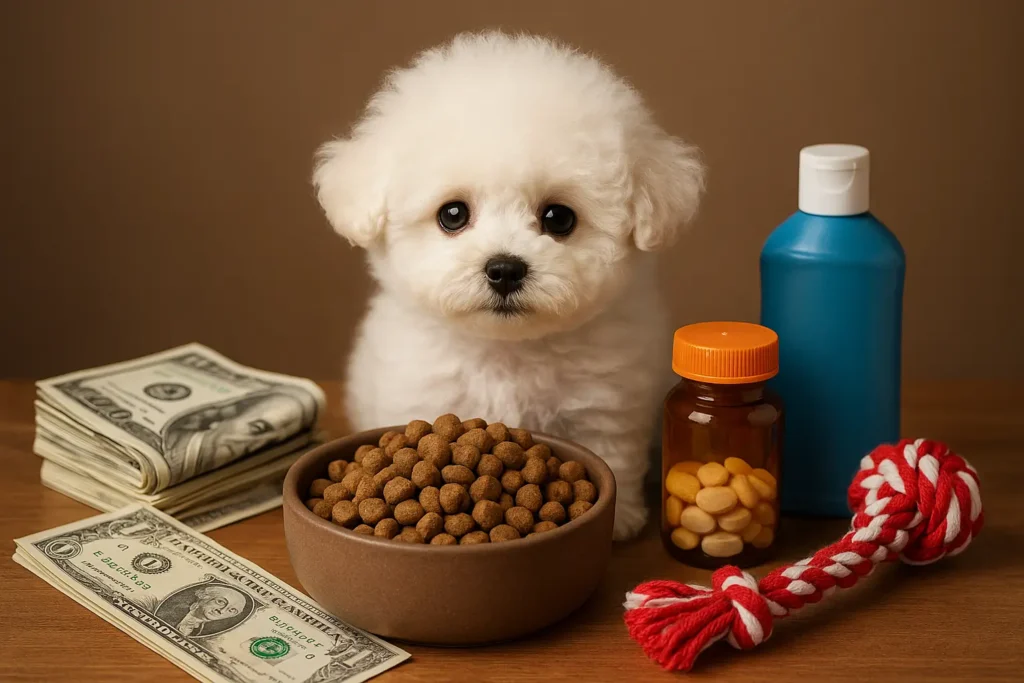
Owning a teacup Bichon Frise isn’t just about the initial price , there are ongoing monthly costs to keep your little fluffball happy and healthy. Here’s a realistic breakdown:
Food
Even though they’re tiny, teacup Bichons need high-quality small-breed dog food packed with protein and nutrients. Because of their size, they eat less than larger breeds, but premium food still adds up.
- Estimated cost: $20 – $40/month
Veterinary
Vet expenses can vary, but you should factor in the basics: routine checkups, flea/tick and heartworm prevention, vaccinations, and dental care. Puppies will cost more in the first year due to spay/neuter and booster shots.
- Estimated cost: $30 – $60/month (averaged over the year)
Grooming
The teacup Bichon Frise’s double coat needs regular maintenance. Expect daily brushing plus professional grooming every 4–6 weeks for trimming, bathing, nail care, and ear cleaning. Skipping this can lead to painful mats.
- Estimated cost: $40 – $80/month
Total Monthly Cost
$90 – $180/month
While the teacup Bichon Frise doesn’t eat much, grooming and vet care are the real ongoing expenses. Their fluffy coat and delicate health mean budgeting ahead is key to keeping them looking and feeling their best.
Diet and Nutrition: Teacup Bichon Frise

Feeding a bichon frise teacup requires careful attention. Because they’re so small, even minor mistakes with diet can affect their health. The goal is a balanced diet that keeps them energized, supports coat health, and prevents low blood sugar (hypoglycemia), which is common in very small dogs.
Monthly Food Expenses
- High-quality small-breed dry kibble or fresh food diet: $20–$40/month
- Puppy food costs slightly more at first since they need specialized, nutrient-dense formulas.
Essential Nutrients
- Protein (22–28%): For muscle growth and energy
- Healthy fats (8–12%): For coat shine, skin health, and brain development
- Carbohydrates: Small amounts for energy, especially from whole grains or vegetables
- Vitamins & minerals: For immune support and bone health
- Omega-3 & Omega-6 fatty acids: Keep the fluffy coat soft and healthy
Foods for Pups (2–12 months)
- Small-breed puppy kibble (brands like Royal Canin, Hill’s, or Wellness)
- Fresh options: boiled chicken, rice, sweet potato, and carrots in small amounts
- How much to feed:
- 3–4 small meals daily (¼ cup each)
- Frequent feeding prevents hypoglycemia
Foods for Adults (12 months+)
- Small-breed adult kibble or fresh food tailored to weight management
- Protein sources: chicken, turkey, lamb, salmon
- Veggies: spinach, peas, pumpkin, broccoli (in moderation)
- How much to feed:
- 2 meals daily (¼–½ cup each, depending on weight/activity level)
Calories Per Day
- Puppies: ~250–300 calories/day (split into 3–4 meals)
- Adults: ~200–250 calories/day (split into 2 meals)
Macro-Nutrient Breakdown
- Protein: 22–28% of daily intake
- Fat: 8–12%
- Carbs: 40–50% (from healthy grains or veggies)
- Fiber: 3–5% for digestion
Never Feed These Foods
- Chocolate
- Grapes & raisins
- Onions & garlic
- Avocado
- Caffeine & alcohol
- Xylitol (found in sugar-free gum/candy)
- Cooked bones (they splinter easily)
Nutritional Tips for a Teacup Bichon
- Stick to small, frequent meals , prevents low blood sugar.
- Use stainless steel bowls to avoid tear staining.
- Keep treats under 10% of daily calories.
- Add omega supplements for coat health.
- Always provide fresh, clean water.
Health of a Full-Grown Teacup Bichon Frise

The full-grown teacup Bichon Frise is small, cuddly, and joyful, but like all teacup-sized dogs, they come with special health considerations. Their tiny frames make them more fragile, and responsible care is the key to helping them live a long, happy life.
Average Monthly Expenses
- Veterinary care: $30–$60 (averaged over a year for checkups, vaccines, and preventatives)
- Emergency/medications: Can spike costs , pet insurance is often recommended
- Total health-related costs: Around $40–$70/month
General Well-Being
- Thrive on routine, love companionship, and enjoy gentle play
- Need consistent grooming and dental care to prevent issues
- Sensitive to stress and loneliness
Common Health Problems
Because of their size, teacup Bichons may face more risks than standard Bichons:
- Hypoglycemia (low blood sugar, especially in puppies)
- Dental crowding & tooth decay due to tiny jaws
- Fragile bones and risk of fractures from jumping or falls
- Patellar luxation (loose kneecaps)
- Allergies & skin issues
- Eye problems such as cataracts or tear staining
Despite this, with proper care, many live 12–15 years.
Energy Level
- Moderate energy, but playful
- Enjoy bursts of zoomies, then settle for snuggles
- Around 20–30 minutes of activity per day is enough
Recognizing Stress
Watch for signs like:
- Excessive barking or whining
- Trembling or hiding
- Loss of appetite
- Over-grooming or licking paws
Stress often comes from being left alone too long or exposed to loud environments.
Medical Care
- Annual checkups (bi-annual for seniors)
- Dental cleanings every 6–12 months
- Parasite prevention (fleas, ticks, heartworms)
- Spay/neuter surgery (if not already done by breeder)
Vaccination Details
Typical schedule for a teacup Bichon:
- 6–8 weeks: DHPP (distemper, adenovirus, parvovirus, parainfluenza)
- 10–12 weeks: DHPP booster + Bordetella
- 14–16 weeks: DHPP final + rabies
- Yearly/3 years: Rabies, DHPP boosters
- Optional: Leptospirosis, Lyme, Canine Influenza (depending on lifestyle)
Recommendations for Senior Dogs
As your teacup Bichon ages (10+ years):
- Switch to senior small-breed dog food (lower calories, joint support)
- Increase vet visits to twice yearly
- Add supplements (omega-3 for joints, dental chews for teeth)
- Provide soft bedding for fragile bones
- Gentle exercise to prevent obesity but avoid overexertion
Care: Exercise Needs of a Teacup Bichon Frise
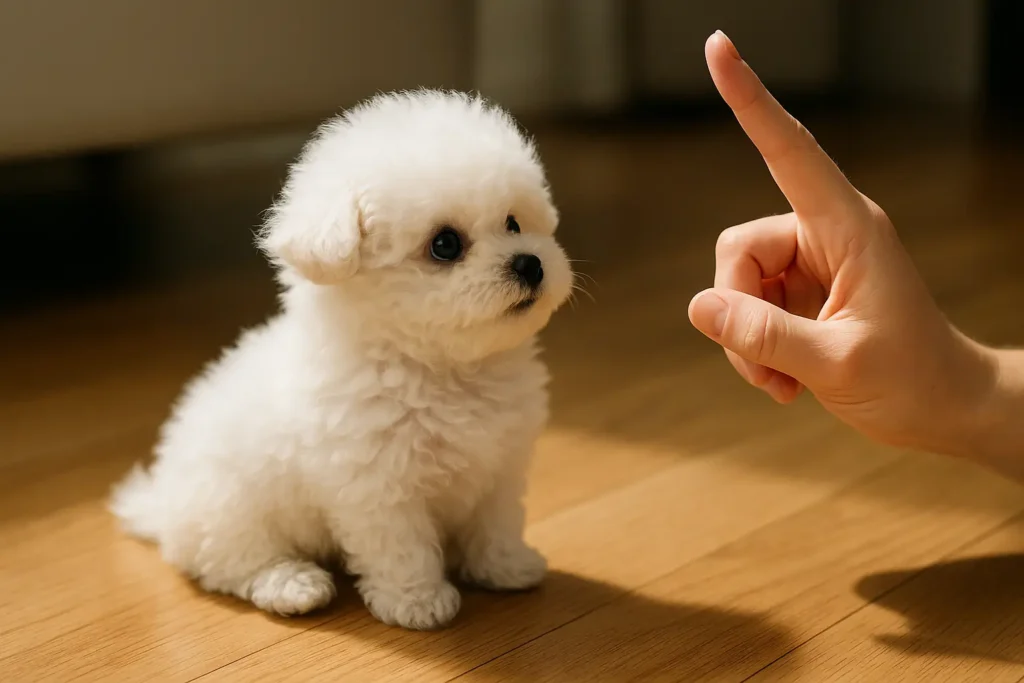
Even though the teacup Bichon Frise is tiny, don’t be fooled , they still need daily activity to stay healthy and happy. Their exercise requirements are manageable compared to large breeds, but consistency is key to preventing boredom, weight gain, and behavioral issues.
High Energy Level
While they’re small, teacup Bichons often have bursts of puppy-like energy. You’ll notice spurts of zoomies around the living room followed by long cuddle naps. They’re not hyper, but they thrive on short sessions of active play.
Intensity
Exercise intensity is light to moderate. A teacup Bichon isn’t built for long hikes or rough play, but short walks, games of fetch, or agility-style activities (scaled down for their size) keep them engaged without overexerting their tiny bodies.
Exercise Needs
- Daily walks: 15–20 minutes, once or twice a day
- Indoor playtime: Tug toys, squeaky toys, or hide-and-seek games
- Mental stimulation: Puzzle feeders or simple trick training sessions
Total activity needed: 20–40 minutes/day
Potential for Playfulness
Teacup Bichons are playful by nature , they love chasing small toys, bouncing around the house, and entertaining their families. This playful streak makes exercise fun and easy to incorporate into everyday routines.
Sample Exercise Routine
- Morning: 10–15 minute walk around the block
- Afternoon: 5–10 minutes of fetch or tug indoors
- Evening: Short training session (sit, stay, or a new trick) followed by cuddle time
- Playtime breaks: Allow free play indoors , safe, carpeted areas help protect their tiny joints
Shedding in Teacup Bichon Frise
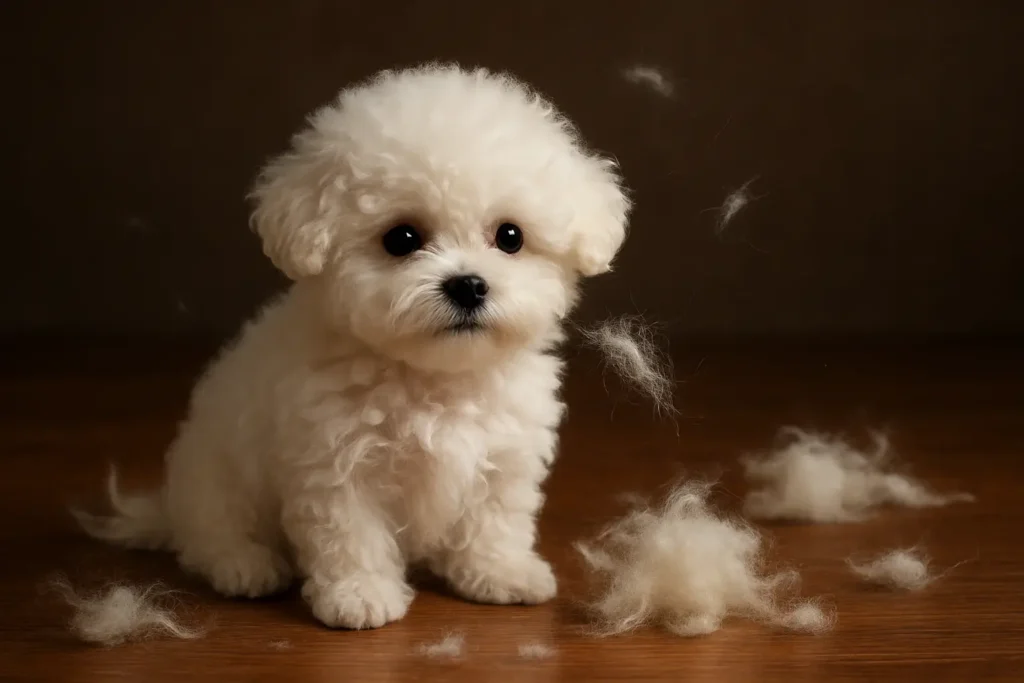
One of the biggest perks of the teacup Bichon Frise is its reputation as a low-shedding, hypoallergenic breed. Unlike many dogs, they don’t shed fur all over your furniture , but that doesn’t mean their coat is effortless to manage.
Shedding Level
- Low shedding
- Their curly double coat traps loose hairs instead of letting them fall to the ground.
- You won’t find big clumps of fur around the house like you would with heavy shedders such as Huskies or German Shepherds.
Why Grooming Still Matters
Because the hair doesn’t fall out naturally, it can mat and tangle if not brushed regularly. This means less vacuuming, but more brushing. A professional grooming session every 4–6 weeks is recommended to keep their coat fluffy and healthy.
Grooming Guide for the Bichon Frise Teacup
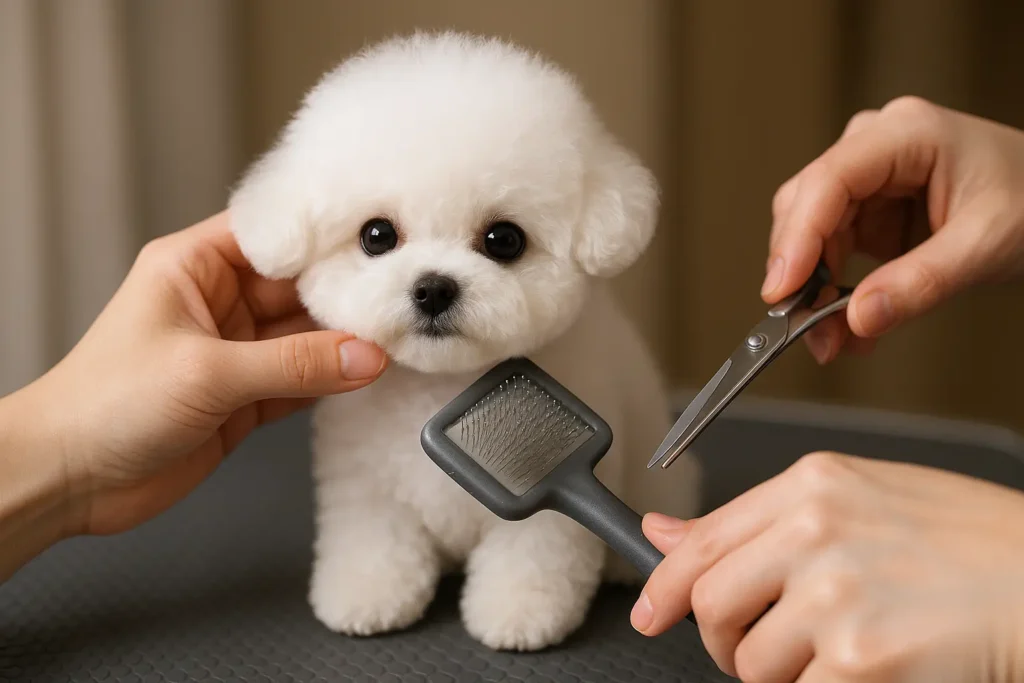
The bichon frise teacup is adorable with its fluffy, cloud-like coat , but that beauty comes with a price. These little dogs are low-shedding but high-maintenance, and regular grooming is non-negotiable for their health and comfort.
Average Monthly Expenses
- Professional grooming: $40–$80 (every 4–6 weeks)
- At-home care supplies: $10–$20 (brushes, shampoos, wipes, nail clippers)
Total: Around $50–$100/month depending on whether you groom at home or rely fully on professionals.
Benefits of Grooming
- Keeps coat soft, fluffy, and mat-free
- Reduces risk of skin irritations and hot spots
- Prevents eye staining (common in Bichons)
- Early detection of lumps, bumps, or skin issues
- Strengthens bond between dog and owner
Hygienic Checklist
- Brush coat daily to prevent mats
- Bathe every 3–4 weeks with dog-safe shampoo
- Wipe eyes daily to avoid tear staining
- Clean ears weekly to prevent infections
- Trim nails every 2–3 weeks
- Brush teeth at least 3–4 times a week
Skin Care
Teacup Bichons are prone to allergies and sensitive skin. Use hypoallergenic shampoos and always dry their coat thoroughly to avoid fungal infections. Coconut oil or vet-approved skin supplements can help soothe dry skin.
Coat Care
- Daily brushing with a slicker brush to remove tangles
- Professional trims in a teddy bear or puppy cut for easier maintenance
- Avoid letting mats form, as they can cause discomfort and skin infections
Eye Care
- Prone to tear staining (brownish marks under eyes)
- Use vet-approved wipes or filtered water to minimize staining
- Regular grooming around the eyes keeps vision clear
Ear Care
- Small floppy ears can trap moisture, leading to infections
- Clean ears weekly with a gentle dog ear cleaner
- Always dry ears after baths to prevent bacterial growth
Nail Care
- Nails grow quickly in small dogs and can curl into paw pads if left unchecked
- Trim every 2–3 weeks, or schedule with your groomer
- Long nails can cause discomfort or even affect posture and walking
Adaptability of the Bichon Frise Teacup
The bichon frise teacup is one of the most adaptable toy breeds, making it a popular choice for city dwellers, families, and seniors alike. Despite their small size, they have big personalities and thrive in many environments , as long as their social and grooming needs are met.
Adapts Well to Apartment Living
Yes, These little fluffballs are perfect for apartments. They don’t need a yard, and their exercise needs can be met with short daily walks and indoor play. Their small size makes them easy to manage even in tight spaces.
Tendency to Bark or Howl
- Moderate barking level.
- They’ll bark when they hear strangers or unusual noises, making them good little watchdogs.
- With proper training and enough attention, they won’t become nuisance barkers.
Good for Novice Dog Owners
Absolutely. The teacup Bichon is gentle, friendly, and eager to please, making them a great first dog. The main challenge for beginners is their grooming routine, which requires consistency.
Sensitivity Level
- Very sensitive to tone of voice and handling.
- Harsh training methods can make them anxious.
- They respond best to positive reinforcement like praise, treats, and gentle correction.
Tolerates Being Alone
- Not well
- Teacup Bichons are prone to separation anxiety.
- They thrive when someone is home most of the time. If left alone too often, they may bark, whine, or become destructive.
Tolerates Cold Weather
- Poor tolerance. Their small size and thin build make them vulnerable in cold climates.
- They’ll need sweaters, coats, or booties for chilly walks.
Tolerates Hot Weather
- Moderate tolerance. They handle mild warmth but are prone to overheating in hot climates.
- Always provide shade, water, and avoid midday walks in summer.
All-Around Friendliness of the Teacup Bichon Frise
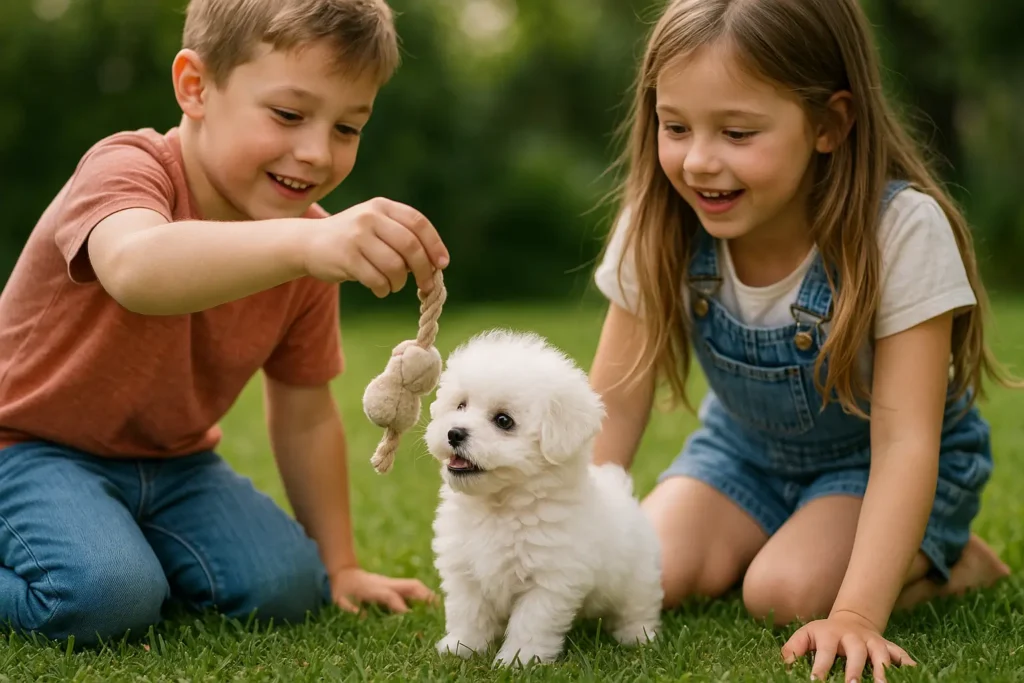
The teacup bichon frise is known for its warm, bubbly personality that makes it one of the most people-loving toy breeds. Their friendliness is a big reason why families and first-time dog owners often fall in love with them.
Best Family Dogs
The teacup Bichon is an excellent family companion. They’re affectionate, playful, and thrive when they’re included in daily activities. They quickly become the “family shadow,” following everyone around and soaking up attention.
Kid-Friendly
- Great with older children who know how to handle a small, delicate dog.
- Because of their tiny size, they can easily be injured by rough play, so supervision around toddlers is essential.
- They’ll happily join in gentle games, cuddles, and nap time with kids.
Dog Friendly
The teacup Bichon is naturally social with other dogs. They enjoy playdates and often do well in multi-dog households, especially when paired with other small or gentle breeds. Early socialization helps strengthen this trait.
Friendly Towards Strangers Unlike some toy breeds that can be reserved, the teacup Bichon tends to be open and welcoming to new people. They may bark when someone first enters, but once they sense no threat, they quickly warm up with tail wags and excitement.
Trainability of a Full-Grown Teacup Bichon Frise

The full-grown teacup Bichon Frise is a smart little dog that loves to please its family, but training can sometimes feel like a balancing act. They’re quick learners with a playful side, yet their sensitive nature and occasional stubborn streak mean patience and consistency are key.
Easy to Train
Teacup Bichons respond beautifully to positive reinforcement like treats, praise, and play. They enjoy learning tricks and routines, especially when training sessions are short and fun. Potty training, however, can be a challenge due to their tiny bladders. Expect a few extra weeks of consistency, puppy pads, and frequent potty breaks.
Intelligence
These pups are bright and intuitive, ranking well in terms of trainability compared to other toy breeds. They can pick up commands quickly and love mental stimulation such as puzzle toys, obedience games, and agility exercises scaled for their size.
Potential for Mouthiness
Like many small breeds, teacup Bichons may go through a mouthy puppy phase where they nip or chew. Providing plenty of safe chew toys helps redirect this behavior. As adults, they’re less prone to destructive chewing, but boredom can still spark it.
Prey Drive
Very low. Teacup Bichons aren’t hunters, they were bred as companion dogs. While they may chase a butterfly or small toy, they don’t typically have the instinct to pursue wildlife or cats.
Wanderlust Potential
Low to moderate. These pups love exploring their surroundings on walks but aren’t escape artists like some breeds. Their strong attachment to owners keeps them close, though supervision is a must since their small size makes them vulnerable outdoors.
Teacup Bichon Frise Puppies
Few things are cuter than a teacup Bichon Frise puppy. With their fluffy coats, button noses, and sparkling dark eyes, they look like tiny teddy bears come to life. These pups are especially delicate in their first months, so understanding their size and care needs is important.
Puppies’ Images

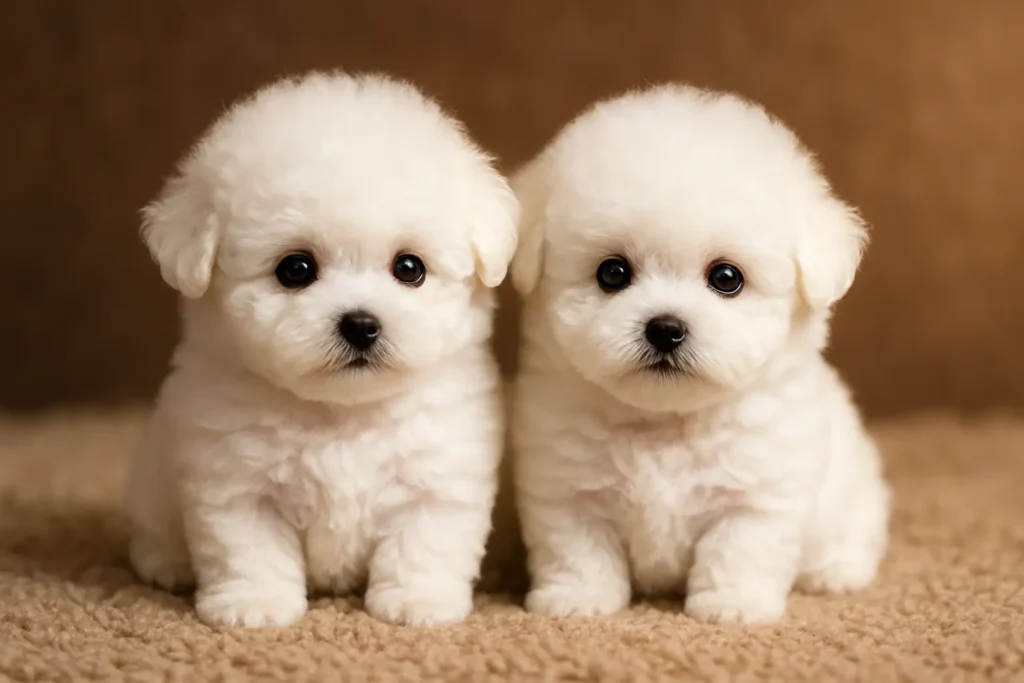
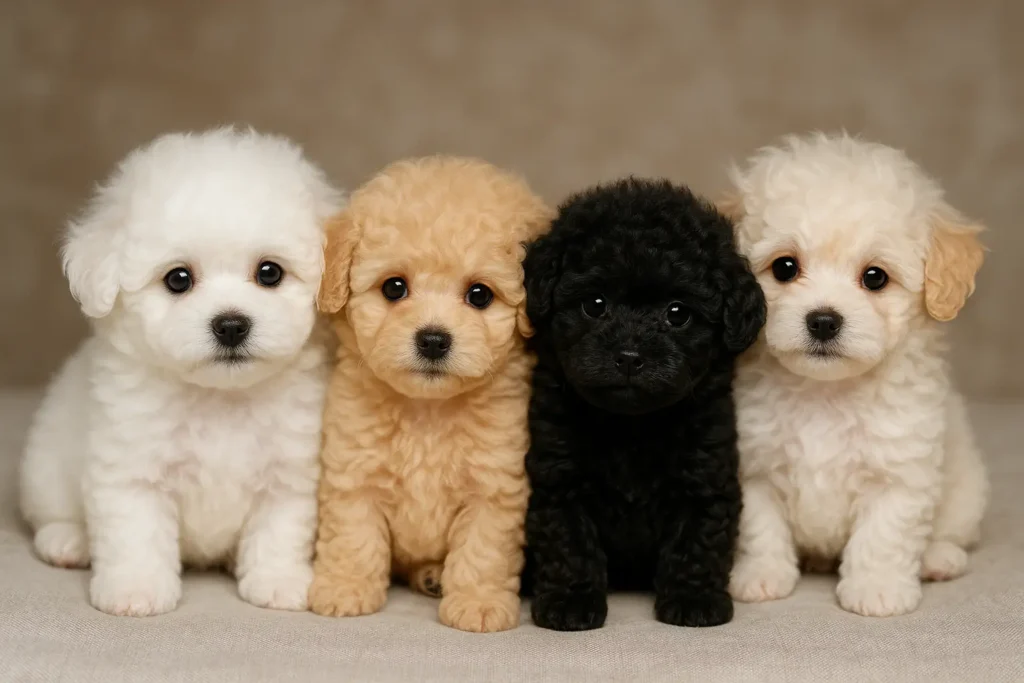
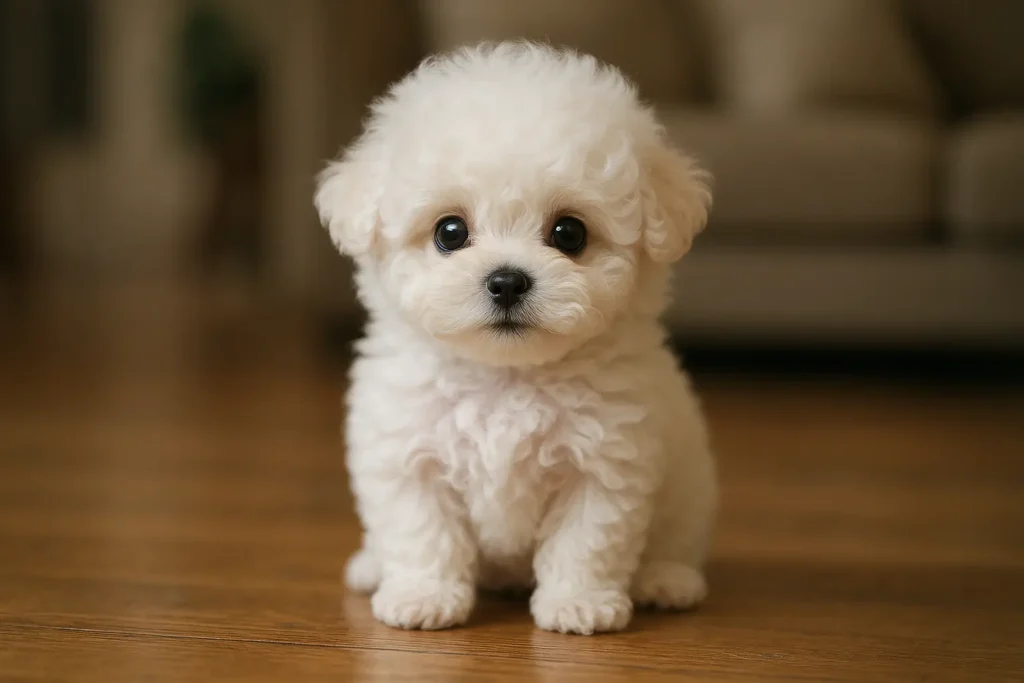
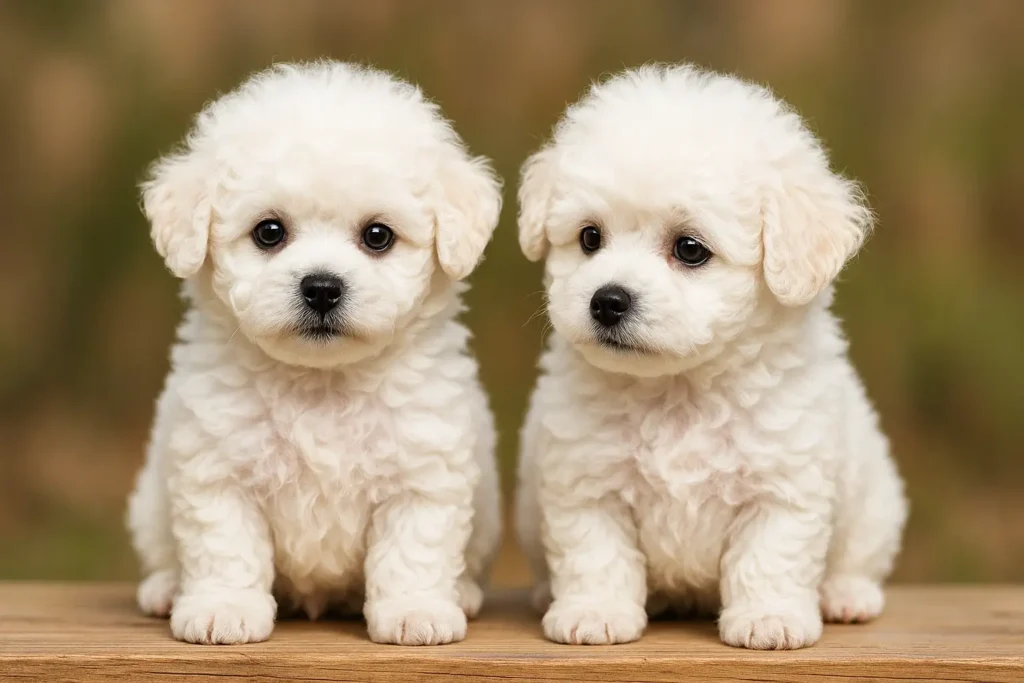


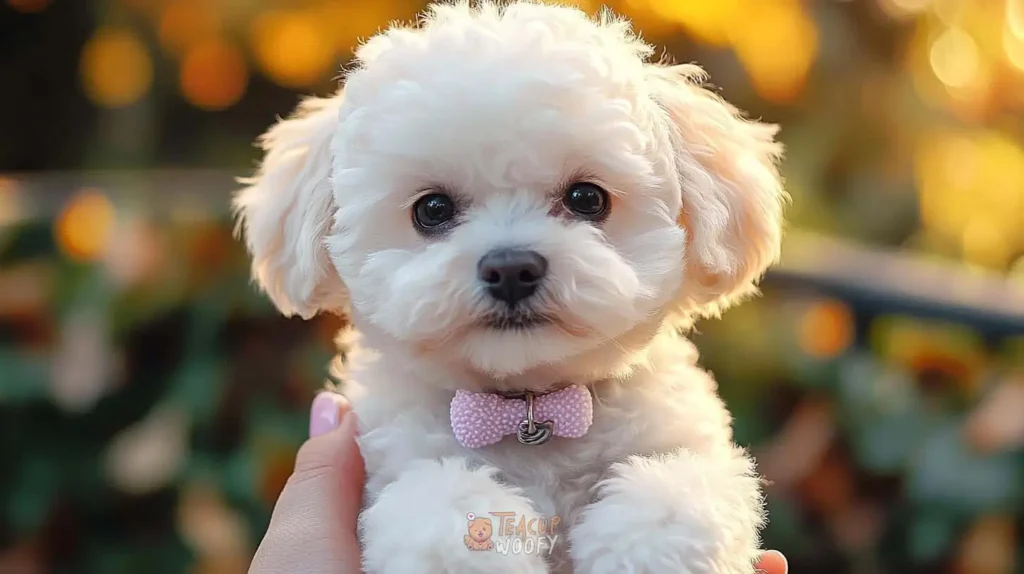
Puppies’ Size
- Birth weight: 4–6 ounces (incredibly tiny and fragile)
- 8 weeks: 1–2 lbs, small enough to fit in two hands
- 3 months: 2–3.5 lbs
- 6 months: 3.5–5.5 lbs
- Full grown (12 months): 5–9 lbs, 7–9 inches tall
Because of their small size, teacup Bichon puppies are prone to hypoglycemia (low blood sugar), so they need small, frequent meals throughout the day.
Male vs Female Teacup Bichon Frise

When choosing a teacup Bichon Frise, you may wonder whether there’s much difference between males and females. While both are affectionate, playful, and charming, there are a few subtle distinctions in size, temperament, and behavior that can help you decide which might be the best fit for your family.
Size Differences
- Males: Typically a bit larger, weighing 6–9 lbs and standing 8–9 inches tall.
- Females: Slightly smaller, averaging 5–8 lbs and 7–8.5 inches tall.
Both remain tiny and perfect for apartment living, but females may feel a little more delicate.
Temperament
- Males: Often described as more affectionate and clingy, sometimes acting like little “velcro dogs.” They crave constant attention and may follow you everywhere.
- Females: Can be a little more independent and reserved, though still loving. They may seek cuddles on their terms rather than all day long.
Behavior
- Males: Tend to be more playful and goofy, keeping their puppy-like energy well into adulthood. They may mark territory if not neutered, though early training helps prevent this.
- Females: Usually quieter and easier to housebreak, with a slightly calmer demeanor. They’re often quicker to mature emotionally than males.
Health & Care
Both sexes share the same health risks common in teacup dogs , dental crowding, fragile bones, and hypoglycemia. Spaying/neutering is recommended to avoid hormonal behavior and health issues.
What to Know Before You Buy or Rehome a Teacup Bichon Frise
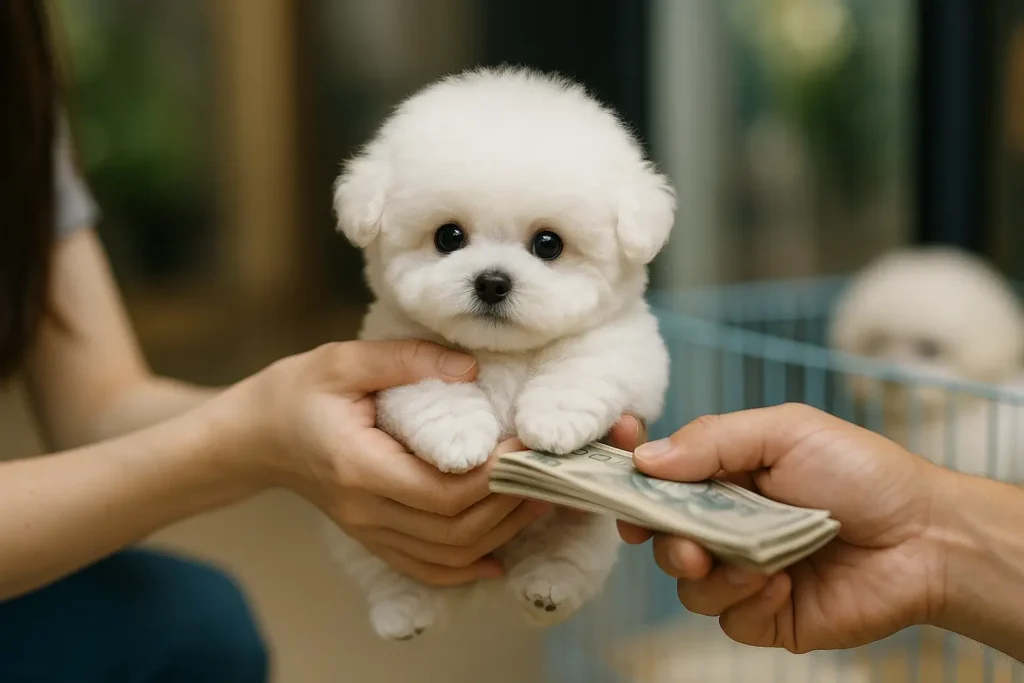
When browsing ads for teacup Bichon Frise price or seeing listings like teacup Bichon puppies for sale, it’s easy to be tempted by their irresistible looks. But before you bring one of these tiny fluffballs home, there are some key things you need to know.
Price Expectations
- Buying from breeders: $2,500–$5,000 USD depending on breeder reputation, size, and rarity (some go even higher for rare shades like cream or brown).
- Adoption fees: $50–$400 USD if you’re lucky enough to find one in a shelter or breed-specific rescue (rare for teacup versions).
- Initial costs: Supplies like crate, carrier, toys, and starter grooming gear can add another $300–$600.
Health Risks
The term “teacup” isn’t recognized by the AKC. Breeding smaller-than-standard dogs sometimes increases the risk of health problems, such as:
- Hypoglycemia (low blood sugar in puppies)
- Fragile bones (risk of injury from falls)
- Dental issues (tiny jaws = crowded teeth)
- Patellar luxation (knee problems)
- Allergies and skin sensitivities
Always ask for genetic testing and health certificates when buying from a breeder.
Monthly Expenses
Even though they’re small, teacup Bichons aren’t “cheap” to keep:
- Food: $20–$40/month
- Veterinary care: $30–$60/month (averaged annually)
- Grooming: $40–$80/month
- Other (gear, toys, training): $20–$40/month
Total average: $120–$240/month
Lifestyle Match
- Perfect for apartments and small homes
- Do best in households where someone is home often (don’t tolerate being left alone long)
- Need gentle handling , not ideal for toddlers but great with older children
- Require daily brushing and professional grooming every 4–6 weeks
Adoption vs Buying
- Adoption: Cheaper, rewarding, and saves a life, but teacup Bichons are rarely found in shelters. Breed-specific rescues may have some.
Buying: More predictable in terms of puppy age, size, and pedigree, but only go through responsible breeders who prioritize health over miniaturization.
10 Fun Facts About the Teacup Bichon Frise
The teacup Bichon Frise may be tiny, but it carries a big personality and a fascinating background. Here are some fun and useful facts about this adorable little breed:
- Royal Roots: The Bichon Frise has a long history as a royal lapdog in France and Spain. Teacup versions keep that same aristocratic charm , just in a smaller size.
- Not an Official Size: The American Kennel Club (AKC) recognizes only the standard Bichon Frise. “Teacup” is a modern term used for selectively bred smaller Bichons.
- Hypoallergenic Coats: Their curly coats are low-shedding and hypoallergenic, making them great for people with allergies.
- Pocket-Sized Companions: A full-grown teacup Bichon Frise weighs just 5–9 pounds and stands only 7–9 inches tall.
- Long Lifespan: With proper care, these little dogs live 12–15 years, sometimes longer.
- Sensitive & Loving: They’re incredibly sensitive to their owner’s emotions and thrive on affection, making them one of the most loyal toy breeds.
- Rare Colors: While classic white is standard, some teacup Bichons are born with cream, apricot, or light brown tints, though these often fade to white as they mature.
- Grooming is a Must: Low shedding doesn’t mean low maintenance. Their coats need daily brushing and professional grooming every 4–6 weeks.
- Prone to Separation Anxiety: They love company so much that being left alone for long periods can cause stress, barking, or destructive behavior.
- Expensive Puppies: Because of their rarity, teacup Bichon Frise puppies for sale can cost anywhere from $2,500 to $5,000 USD, depending on breeder and pedigree.
Final Thoughts
Owning a teacup Bichon Frise is like having a tiny ball of sunshine in your life. They might be small, but their love and energy fill your whole home. With the right care, nutrition, and a little daily pampering, these fluffy companions can bring years of joy and laughter. If you’re ready for a loyal, affectionate pup that will follow you everywhere (even to the bathroom, let’s be honest), then a teacup Bichon Frise might just be your perfect match.
Frequently Asked Questions:
How much does a teacup Bichon Frise cost?
A teacup Bichon Frise usually costs between $2,500 and $5,000 USD, depending on breeder reputation, size, and pedigree.
How long does a teacup Bichon Frise live?
With good care, they live about 12–15 years, and some may live even longer.
Are teacup Bichon Frises good family pets?
Yes, They’re affectionate, playful, and gentle, making them great with older children and friendly with other pets.


